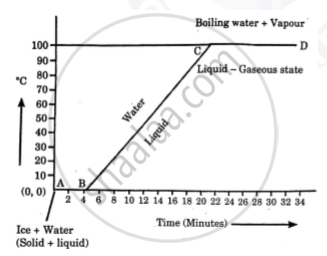Advertisements
Advertisements
प्रश्न
1 kg of water is contained in a 1.25 kW kettle. Assuming specific heat capacity of water = 4.2 J/g °C and specific latent heat of vaporization = 2260 J/g, calculate:
(i) the time taken for the temperature of water to rise from 25°C to its boiling point,
(ii) the mass of water which evaporates per minute from the boiling water.
उत्तर
(i) Heat required for the temperature of 1 kg (= 1000 g) of water to rise from 25°C to its boilling point (i.e. 100°C)
= Mass × Specific heat capacity × Rise in temperature
= 1000 × 4.2 × (100 - 25) = 31500 J
Power supplied by the kettle = 1.25 kW = 1.25 × 1000 W = 1250 W
Since Power = `"Energy"/"Time"`
`therefore 1250 = 31500/"t"`
Hence time taken t = `315000/1250 = 252"s"` (or 4 min 12 s)
(ii) Energy supplied by the kettle in 1 minute (= 60s) = Power × Time
= 1250 × 60 = 75000 J
Heat required for boiling water to evaporate
= Mass × Specific latent heat of vaporization
= m × 2260 = 2260 mJ
Thus 2260 m = 75000
or mass of water evaporated per minute, m = `75000/2260 = 33.18 "g"`
APPEARS IN
संबंधित प्रश्न
What do you understand by the term latent heat?
- Which requires more heat: 1 g ice at 0℃ or 1 g water at 0℃ to raise its temperature to 10℃?
- Explain your answer in part (a).
Explain the following:
The heat supplied to a substance during it change of state, does not cause any rise in its temperature.
Explain the following temperature vs time graph.

Explain the following temperature Vs. time graph:

Explain why water is used in hot water bottles for fomentation and also as a universal coolant.
What happens to the heat supplied to a substance when the heat supplied causes no change in the temperature of the substance?
Why does weather become pleasant when it starts freezing in cold countries?
What observation you will record and how will you determine the specific latent heat of fusion of ice?
Steam at 100°C is passed over 1000 g of ice at 0°C. After some time, 600 g of ice at 0°C is left and 450 g of water at 0°C is formed. Calculate the specific latent heat of vaporization of steam (Given: specific heat capacity of water = 4200 J/kg°C, specific latent heat of fusion of ice = 336,000 J/kg.)
Match the columns.
| Column A | Column B |
| 1) Specific latent heat of fusion | a) Air saturated with vapour |
| 2) Specific latent heat of vaporisation | b) Solid converts into liquid |
| 3) Dew point temperature | c) liquid converts into gas |
Match the columns.
| Column A | Column B |
| 1) Absolute humidity | a) J or cal |
| 2) Latent heat | b) J/kg °C |
| 3) Specific heat capacity | c) kJ/kg |
| 4) Heat | d) no unit |
| e) kg/m3 |
1 kg of dry air at a temperature of 40 °C can hold a maximum of 49 g of water vapour.
Write scientific reason.
The bottom of some steel utensils used for cooking is copper.
Define specific latent heat capacity
Specific latent heat L = ______.
Who introduced the term latent heat?
Calculate the amount of heat required to convert 200g of ice at 0°C into the water at 0°C Specific latent heat of fusion of ice = 336 Jg-1
